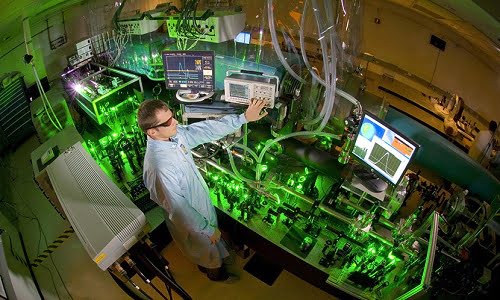The University of Texas at Austin will be a key player in LaserNetUS, a new national network of institutions operating high-intensity, ultrafast lasers.
UT Austin houses one of the most powerful lasers in the country, the Texas Petawatt Laser. The university will receive $1.2 million to fund its part of the network.

Texas Petawatt Laser. Courtesy of the University of Texas at Austin.
Petawatt lasers generate light with at least a million billion watts of power, or nearly 100 times the output of all the world's power plants — but only in the briefest of bursts. Using the technology, called chirped pulse amplification, pioneered by two of the winners of this year’s Nobel Prize in physics, petawatt lasers fire off ultrafast bursts of light shorter than a tenth of a trillionth of a second.
UT Austin has operated its petawatt laser for the past 10 years. Todd Ditmire, director of UT Austin’s Center for High Energy Density Science, told Photonics Media that he’s excited to be able to offer the Texas Petawatt to outside users for collaborative experiments.
“Working with scientists from Stanford, we will use the laser to explore accelerating protons to energies above 100 MeV and will use these bursts of protons to study the physics of how proton ionizing radiation damages materials,” he said. “We will use the laser to accelerate electrons to extremely high energies above 3 GeV and study how those electrons can be used to make extremely bright bursts of femtosecond x-ray pulses.”
Ditmire said another focus will be on understanding astrophysical phenomena by studying laser-driven explosions in external magnetic fields to mimic the physics of supernovae.
“Working with a professor from Rice, we will attempt to use the laser to produce a plasma composed of electrons and positrons,” Ditmire said. “Such plasma are thought to exist near black holes and play a role in extragalactic gamma ray bursts.”
UT operates one of the two petawatt lasers in the newly created LaserNetUS; the Lawrence Berkeley National Laboratory has the other.
Ditmire emphasized that not only will UT researchers derive huge benefits from LaserNetUS, but so will collaborators from all over the country.
The Texas Petawatt Laser will play a varied role within LaserNetUS, spanning plasma physics, radiation physics, acceleration science, ultrastrong-field atomic physics, and astrophysics.
LaserNetUS will provide U.S. scientists increased access to the unique high-intensity laser facilities at nine institutions: UT Austin, Ohio State University, Colorado State University, the University of Michigan, University of Nebraska-Lincoln, University of Rochester, SLAC National Accelerator Laboratory, Lawrence Berkeley National Laboratory, and Lawrence Livermore National Laboratory.